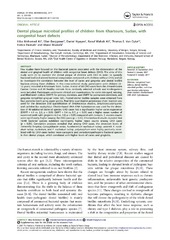| dc.contributor.author | Mohamed Ali, Hiba | en_US |
| dc.contributor.author | Berggreen, Ellen | en_US |
| dc.contributor.author | Nguyen, Daniel | en_US |
| dc.contributor.author | Ali, Raouf Wahab | en_US |
| dc.contributor.author | Van Dyke, Thomas E. | en_US |
| dc.contributor.author | Hasturk, Hatice | en_US |
| dc.contributor.author | Mustafa, Manal | en_US |
| dc.date.accessioned | 2018-03-27T11:28:32Z | |
| dc.date.available | 2018-03-27T11:28:32Z | |
| dc.date.issued | 2017 | |
| dc.Published | Mohamed Ali HM, Berggreen E, Nguyen D, Ali RW, Van Dyke, Hasturk H, Mustafa M. Dental plaque microbial profiles of children from Khartoum, Sudan, with congenital heart defects. Journal of Oral Microbiology. 2017;9:1281556 | eng |
| dc.identifier.issn | 2000-2297 | |
| dc.identifier.uri | https://hdl.handle.net/1956/17564 | |
| dc.description.abstract | Few studies have focused on the bacterial species associated with the deterioration of the dental and gingival health of children with congenital heart defects (CHD). The aims of this study were (1) to examine the dental plaque of children with CHD in order to quantify bacterial load and altered bacterial composition compared with children without CHD; and (2) to investigate the correlation between the level of caries and gingivitis and dental biofilm bacteria among those children. In this cross-sectional study, participants were children (3–12 years) recruited in Khartoum State, Sudan. A total of 80 CHD cases from the Ahmed Gasim Cardiac Centre and 80 healthy controls from randomly selected schools and kindergartens were included. Participants underwent clinical oral examinations for caries (decayed, missing, and filled teeth indices [DMFT] for primary dentition, and DMFT for permanent dentition), and gingivitis (simplified gingival index [GI]). Pooled dental biofilm samples were obtained from four posterior teeth using paper points. Real-time quantitative polymerase chain reaction was used for the detection and quantification of Streptococcus mutans, Streptococcussanguinis, and Lactobacillus acidophilus. Checkerboard DNA–DNA hybridization was used for the detection of 40 additional bacterial species. CHD cases had a significantly higher caries experience (DMFT = 4.1 vs. 2.3, p < 0.05; DMFT = 1.4 vs. 0.7, p < 0.05) and a higher mean number of examined teeth with gingivitis (4.2 vs. 2.0; p < 0.05) compared with controls. S. mutans counts were significantly higher among the CHD cases (p < 0.05). Checkerboard results revealed that 18/40 bacterial species exhibited significantly higher mean counts among CHD cases (p < 0.01). Correlation analyses revealed that among CHD cases, the detection levels of Tannerella forsythia, Campylobacter rectus, Fusobacterium nucleatum subsp. vincentii, F. nucleatum subsp. nucleatum, and F. nucleatum subsp. polymorphum were highly positively correlated with GI. CHD cases harbor more cariogenic and periodontopathogenic bacterial species in their dental plaque, which correlated with higher levels of caries and gingivitis. | en_US |
| dc.language.iso | eng | eng |
| dc.publisher | Taylor & Francis | eng |
| dc.rights | Attribution CC BY-NC | eng |
| dc.rights.uri | http://creativecommons.org/licenses/by-nc/4.0/ | eng |
| dc.subject | Children | eng |
| dc.subject | congenital heart defects | eng |
| dc.subject | dental biofilm | eng |
| dc.subject | microbial profiles | eng |
| dc.subject | real-time quantitative polymerase chain reaction | eng |
| dc.subject | checkerboard DNA–DNA hybridization | eng |
| dc.title | Dental plaque microbial profiles of children from Khartoum, Sudan, with congenital heart defects | en_US |
| dc.type | Peer reviewed | |
| dc.type | Journal article | |
| dc.date.updated | 2018-01-10T10:36:49Z | |
| dc.description.version | publishedVersion | en_US |
| dc.rights.holder | Copyright 2017 The Author(s) | |
| dc.identifier.doi | https://doi.org/10.1080/20002297.2017.1281556 | |
| dc.identifier.cristin | 1479003 | |
| dc.source.journal | Journal of Oral Microbiology | |

